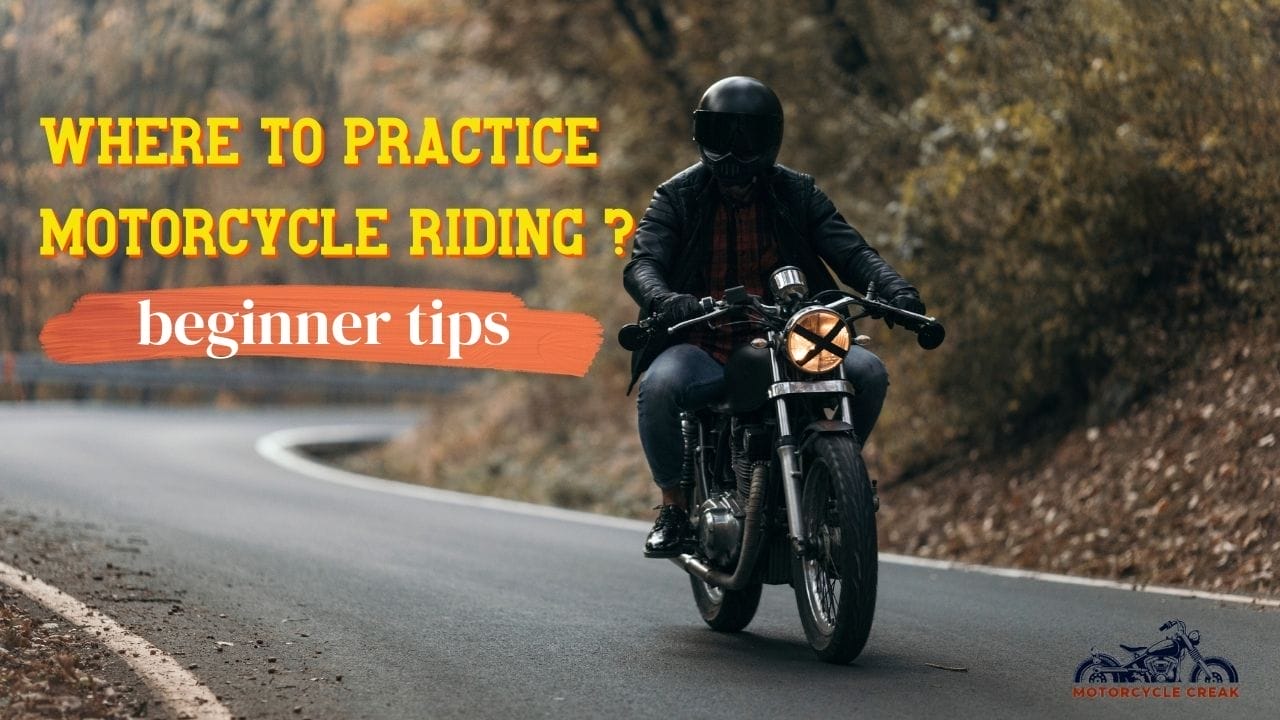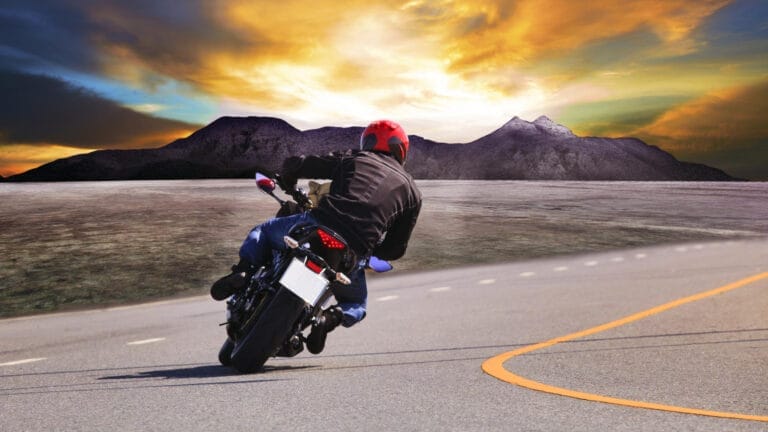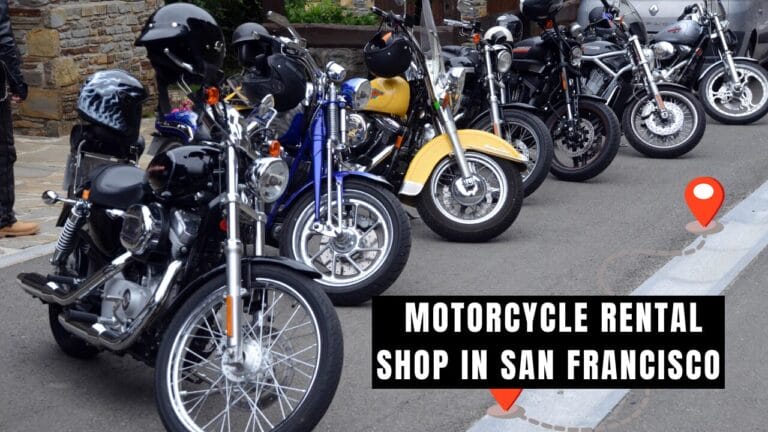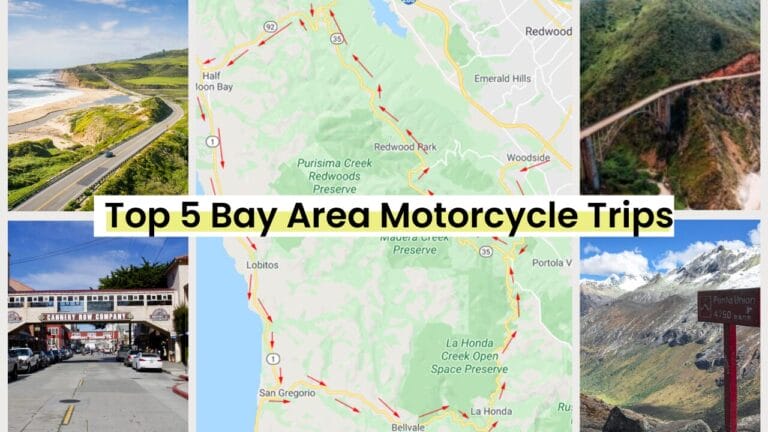Where To Practice Motorcycle Riding ? The Ultimate Guide
Practice makes a man perfect, and it’s not different for a motorcycle rider like you. Whether you’re a newbie gearing up for your first spin or a seasoned pro looking to fine-tune your skills, practicing in the right place with right equipment and following the right technique are the secrets that will help you scale up your skill.
Most city riders ask where to practice motorcycle riding, as they need a place with enough space, reduced traffic, and a distraction free controlled environment in this regard. When you are living in busy areas with not enough space or environment, it’s difficult to find such perfect spot.

And you are not alone; all city riders face this problem. But don’t be worried; I have a few place suggestions available surround you. You don’t have to go a long way to practice motorcycle riding anymore.
We will know about those ideal locations to hone your riding prowess, but before that, I will tell you how location affects your practice. Additionally, finding the right playground is not enough to improve your riding skills. So, I will also provide some helpful tips and tricks to make the most of your practice sessions. Grab your helmet, and let’s hit the road together.
Does Location Affect Motorcycle Riding Performance?
Yes, location affects motorcycle riding performance. A good spot for practicing minimizes the risk of accidents, ensuring a safer learning experience. A few more benefits are also there; let’s know them.
Skill Development:
The chosen practice spot greatly influences a rider’s skill development. Ideal locations offer enough space and a controlled setting for riders to focus on fundamental skills such as braking, turning, and maneuvering without the complexities of real-world traffic.
Confidence Building:
A suitable practice environment helps build rider confidence. Beginners can gain confidence in their abilities and gradually progress to more challenging situations as they become more comfortable with their motorcycles.
Reduced Distractions:
Distractions can hinder the learning process. The right practice location minimizes external distractions, allowing riders to concentrate on mastering essential skills without unnecessary stress or interruptions.
Risk Mitigation:
Learning in a controlled space minimizes the risk of unexpected challenges or hazards that riders might face on busy roads. This controlled environment allows for a gradual learning curve, reducing the likelihood of accidents and building rider competence.
Comfort Zone Expansion:
Starting in an appropriate practice area serves as a stepping stone for riders to expand their comfort zones. As they become more proficient, they can gradually venture into more diverse and challenging riding scenarios.
Legal Compliance:
Using designated practice areas or private spaces ensures compliance with local laws and regulations. Riding in unauthorized or unsafe areas may lead to legal consequences.
Where To Practice Motorcycle Riding- 5 Best Places
Empty Parking Lots
Empty parking lots are a large, open spaces perfect for beginners to practice motorcycle riding. The absence of traffic in parking lots reduces the risk of motorcycle accident, creating a safer environment for learning. Beginners can focus on mastering basic maneuvers like turns, stops, and starts in parking lots.
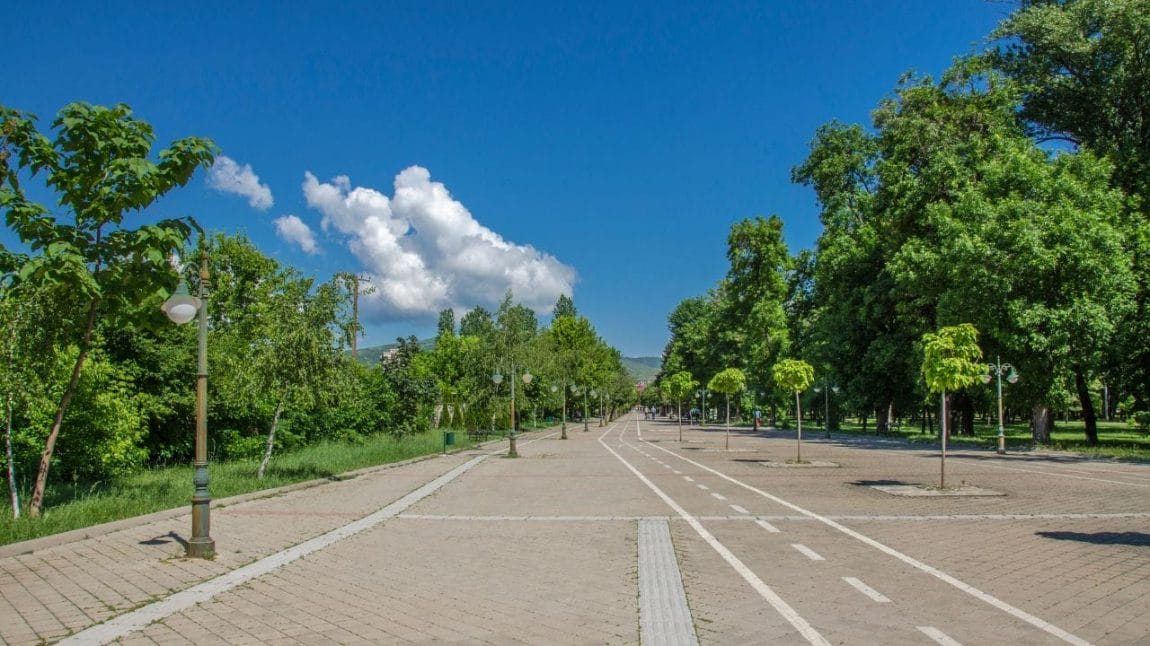
But be careful when finalizing parking lots for motorcycle riding. Look for well-maintained and smooth surfaces to ensure stability and control. Inspect the area for debris, potholes, or any potential hazards. And if you are beginner, prioritize flat terrain to manage your bike easily.
Another thing is local law and regulation; some authorities don’t allow practicing in parks. So, ensure the parking lot you choose allows practice motorcycle riding. Nowadays, some parks have designated spaces for motorcycle practice; you can find them, pay, and practice without worrying.
Private property
Private property is another ideal location for motorcycle riding practice. There is less chaos and more control over the setting. Without the presence of other vehicles, pedestrians, or external noise, riders have reduced distraction levels. This allows riders to concentrate fully on improving their riding skills.
Plus, private property minimizes safety concerns, like lower risk of accidents and collisions with other road users or vehicles. This creates a safer space for beginners to learn and allows experienced riders to experiment with advanced techniques.

Additionally, the private nature of the property ensures privacy. Riders may find it easier to try out new tricks and approaches in this private setting without worrying about looking foolish.
Finally, private property may offer flexibility in practice hours. Depending on the owner’s permissions, riders can practice during off-peak hours, avoiding crowded times.
Neighborhood areas
Neighborhood area is the next place on my list. This location replicates real-world riding conditions, such as traffic, intersections, and road features. Negotiating these challenges builds a well-rounded skill set and improves adaptability and responsiveness to a variety of riding situations.

It is easier to focus on developing specific skills when you practice in neighborhoods during off-peak hours, just like when you practice on private property.
Additionally, neighborhood areas are easily accessible to local riders. So, riders can easily participate in regular practice sessions because they are close to home.
Finally, practicing in neighborhoods fosters a sense of community connection. You can establish positive relationships with your neighbors while promoting motorcycling as a responsible and enjoyable activity.
Closed School Campuses
School campuses often have large open areas and are typically unusable during non-school hours. You can take this chance and practice during those hours without interruptions.
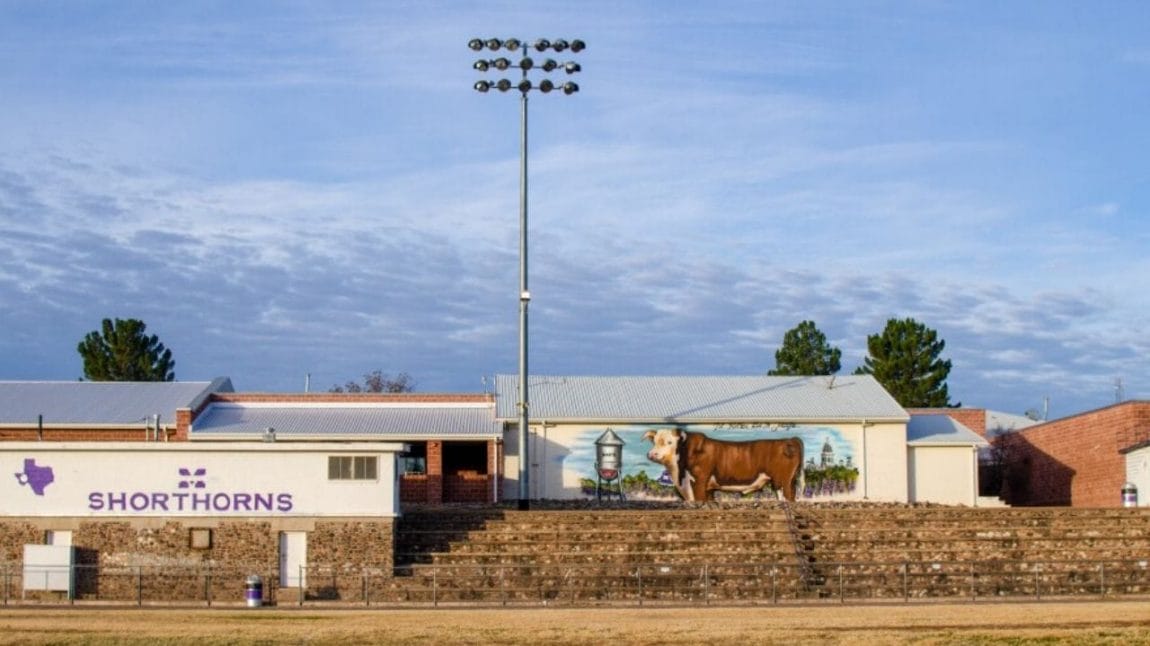
Plus, school campuses have varied terrain, such as asphalt and concrete, commonly found in urban and suburban settings. So, along with practicing, you can work to develop your riding skills, like parking, low-speed maneuvers, and tight turns.
Furthermore, school campuses are typically located in convenient areas for students to access. So you won’t have to travel far away to access regular and consistent practice sessions. Some school campuses also have specific areas designated for recreational activities or sports, providing riders with dedicated spaces for motorcycle practice. But make sure you obtain permission from school authorities and follow motorcycle safety foundation rules to avoid accidents.
Rider Programs
Rider programs have dedicated areas, such as dedicated tracks, practice areas, and classrooms, for specific maneuvers. These areas are specifically designed for motorcycle training with open road, offering a controlled setting where riders can systematically develop and improve their skills under the guidance of certified instructors.
Traffic safety is a central focus of rider programs. So, they make sure the environment is safe for any kind of learning or skill-developing practice.
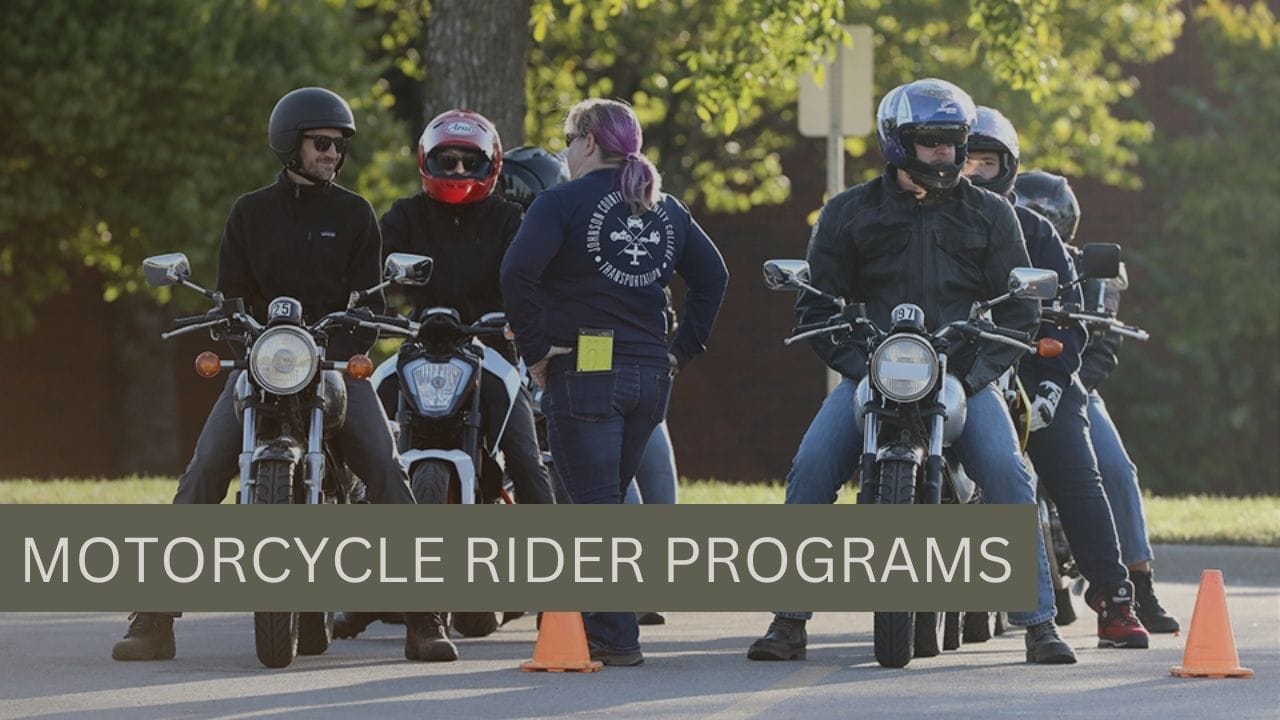
This type of basic ridercourse often follow a structured curriculum designed to cover a range of riding skills, from basic maneuvers to advanced techniques. They also provide training equipment including motor vehicles, reducing the initial investment and ensuring access to suitable gear for effective practice.
Rider programs foster a sense of community; they connect with fellow motorcyclists, share experiences, and participate in a community that promotes responsible and enjoyable motorcycle riding. Furthermore, rider programs offer access to valuable resources and information that enhance the overall riding experience. Whether it’s learning about the latest safety tips, discovering new riding routes, or staying updated on local motorcycle events, these programs provide riders with the tools to make the most out of their passion for motorcycling. With the advancement of technology, riders can also take advantage of the top motorcycle apps for 2024, which provide real-time navigation, weather updates, and even community forums to connect with other riders. These apps further integrate motorcyclists into a connected and informed riding community.
Once the learning is complete they will do a road test to know how much you have learned or if you are ready to ride on an open road or not. If you pass this test you will get a motorcycle permit certificate. Through this, you can buy a motorcycle and practice with confidence.
So, if you want to practice in a well-rounded and supportive environment for skill development that emphasizes safety, professional guidance, and a structured approach to learning, a professional riding place is the best option.
Best Time To Practice Motorcycle Ride: When to Ride?
The best time for motorcycle riding practice depends on personal preferences, local traffic patterns, and weather conditions. Riders should choose a time that aligns with their comfort level, offers optimal visibility, and allows for focused practice without unnecessary distractions.
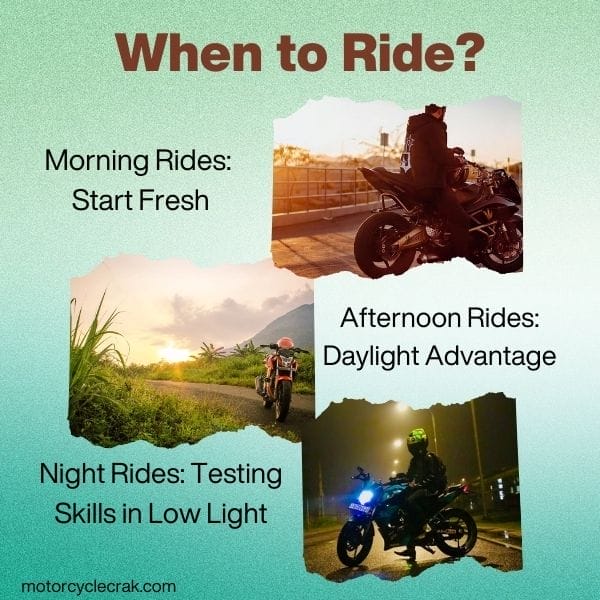
Here are considerations for different times of the day:
Morning Rides: Start Fresh
Starting the day with a refreshing morning ride offers quiet roads and serene surroundings. This enhances motorcycle riding skills and sets a positive tone for the rest of the day. Early morning rides are a great way to build riding confidence and prepare for the day ahead. But be mindful of morning rush hour traffic if you are practicing in urban areas.
And don’t forget to check for morning dew or wet surfaces before going out for practice. It can affect traction.
Afternoon Rides: Daylight Advantage
When riding in the afternoon, there’s a daylight advantage that enhances safety and visibility. But, afternoons have busier traffic, which is a disadvantage. However, it can also be beneficial. You have an opportunity to practice under varied traffic scenarios that will help you handle and ride a motorcycle in traffic. But be very careful; don’t hit someone or injure yourself. If you are not confident enough, avoid afternoon rides.
Night Rides: Testing Skills in Low Light
Night rides enhance alertness and confidence, which are essential for mastering motorcycle riding. Limited visibility at night requires heightened attention to road signs, hazards, and other vehicles. This sharpens riders’ focus, prepares them for unexpected situations, and improves their decision-making skills.
But if you are an absolute beginner, avoiding night rides is best.
Early morning rides provide a fresh start to the day, while afternoon rides offer ample daylight. Night rides allow for testing skills in low light conditions. Choose the time that suits your preferences and enhances your overall riding experience.
Enhancing Your Riding Skills: Tips and Techniques
Enhancing your motorcycle riding skills is a continuous process that involves practice, awareness, and a commitment to safety. Here are some tips and techniques to help you become a more skilled and confident rider:
- Regular practice is essential for skill enhancement. It enhances proficiency, which is essential for navigating different riding scenarios with ease and skill.
- Stay focused on the road, avoid distractions, and maintain mental discipline. Riding requires full attention and quick decision-making. Specially when you are a basic rider.
- Always wear proper motorcycle gear, including a helmet, gloves, jacket, pants, and boots. Safety gear provides essential protection in the event of a fall or collision.
- Focus on basic skill such as emergency braking, acceleration, and steering with precision. Develop a solid grasp of these fundamental maneuvers to enhance your overall control and confidence on the road as a novice rider.
- Learn how to flexibly position your body in various riding situations, particularly when leaning into turns. This includes maintaining your balance and alignment with the motorcycle.
- Make yourself visible to other road users by using proper lighting and wearing high-visibility gear.
- Join group rides or ride with experienced rider. Observe their motorcycle riding skills, how they handle everything, etc., to learn advanced riding techniques.
- Stay aware of road conditions, weather, and potential hazards. Adjust your riding style accordingly, especially in adverse conditions.
- Finally, you can enroll in a motorcycle safety course, where certified instructors provide structured training and guidance. These courses cover essential riding skills and safety principles and may lead to certification or endorsement.
Remember, becoming a skilled rider is a gradual process, and consistent practice is key. Stay committed to learning, be aware of your surroundings, and prioritize safety on all your rides.
Get A License First !!!
While some say you should get a license first before practicing motorcycle riding, I don’t agree with them. Unless you break any laws, nothing will happen to you. If you already know how to ride, then why do you need to practice? If you are an expert rider or qualified enough to pass the skills test and get a driver license, you don’t need practice. It’s different if you are practicing to become a better rider.
But in general, most of the riders practice to learn motorcycle riding, and I think they don’t need a valid motorcycle license to learn or practice motorcycle riding. However, remember, you shouldn’t go on public road or in a traffic area; practice in the mentioned area.
However, if it’s possible in your state to get a motorcycle license first without knowing about motorcycle riding, you should grab one and stay risk-free. Some countries provide motorcycle learner permit, you can try to get one if available in your country.
FAQ
What Is The Best Way To Learn Motorcycle Riding?
The best way to learn motorcycle riding is to take a motorcycle riding course from a reputed institute. This type of basic rider course covers fundamental riding skills, safety principles, and defensive techniques. Instructors provide hands-on training with their motorcycles, also reducing the need for an initial investment. And once you complete the course, you get a certificate or motorcycle endorsement. Then buy your own motorcycle and practice regularly to become a skilled and responsible motorcyclist.
How Do I Get In Shape For Riding A Motorcycle?
Prepare for motorcycle riding by improving cardiovascular fitness with activities like running. Enhance strength through exercises like squats, and prioritize flexibility with stretches. Practice balance and coordination exercises, incorporating yoga or specific drills. Gradually increase the riding duration to build endurance. Mimic riding postures during strength and flexibility exercises. Maintain a healthy lifestyle, including a balanced diet and proper hydration.
What Is The Best Time To Practice Riding A Motorcycle?
The best time to practice riding a motorcycle is during daylight hours, when visibility is optimal. Early morning or late afternoon may offer cooler temperatures and quieter traffic. Avoid peak hours when traffic is heavy. Additionally, choose times when you feel alert and focused. Always check the weather conditions and ensure good visibility.
Regardless of the time, prioritize safety by wearing proper gear, adhering to traffic rules, and selecting a suitable practice area.
What Should A Beginner Motorcycle Practice?
A beginner rider should practice fundamental skills like smooth starts/stops, turning, braking, low-speed maneuvers, gear shifts, and scanning for hazards. They should also learn proper road positioning, basic maintenance checks, and gradually ride in light traffic. Finally, mastering emergency procedures for unexpected situations should also be a priority.
Does Riding A Motorbike Make You Stronger?
Yes, riding a motorbike can make you stronger. Motorbike riding requires engaging various muscle groups, including those in the core, legs, and arms. Constant adjustments to control the bike, maintain balance, and navigate turns can lead to increased muscle tone and build core strength and endurance.
However, how much stronger riding a motorcycle can make you depends on factors such as the type of motorcycle, riding conditions, and your level of physical engagement.
While it may not replace a dedicated exercise routine, regular motorcycling can complement an active lifestyle and positively impact certain aspects of physical fitness.
How Do I Keep My Bike Balance?
Use your legs for balance, distribute your weight evenly, and maintain a relaxed grip to keep your bike balanced. Look ahead, steer and brake smoothly, and adjust your body position when turning. Practice slow motion techniques frequently, and pay attention to the wind.
Ensuring proper tire inflation is also essential for stability. Consistent practice builds confidence and enhances your ability to keep the bike balanced.
Is Riding A Motorcycle A Skill?
Yes, riding a motorcycle is a skill that involves a combination of physical coordination, situational awareness, and technical proficiency. It includes learning how to handle the bike, navigate various road conditions, execute maneuvers, and make quick decisions in response to changing situations.
Final Words
Whether it’s private properties, big box parking lots, neighborhood areas, off-road parks, or repurposed shopping centers, each location offers unique advantages for practice. Additionally, timing your practice sessions, such as morning rides for a fresh start or night rides to test your skills in low light, can further enhance your riding abilities.
Remember to prioritize safety by wearing essential riding gear, ensuring your motorcycle is in optimal condition, and checking safety features before each practice session. Practice and dedication will help you become a skilled and confident motorcycle rider.

